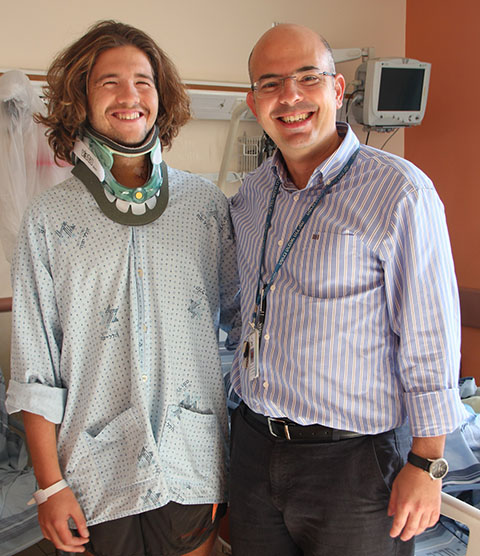All Yarden Kaplan, 24, from Aviel did was take a dive into the pool, the same pool he had dived into and swam in many times in recent years. But something went wrong this time, and he almost became paralyzed from the neck down. Emergency 10-hour surgery by Dr. Eyal Behrbalk, Director of the Spinal Unit in the Orthopedics B Department at Hillel Yaffe Medical Center, saved his life. The professional literature reports on only isolated incidents of patients surviving this type of injury without neurological damage or paralysis.
"It all started Sunday afternoon last week," says Yarden's mother. "I heard Yarden call to me from outside to come quickly. I knew he was in the pool, so I went out there. He stood in the pool and told be that he was hurt and couldn't feel his arms. I helped him get out and went to bring cream to anesthetize the injured area. I realized that he had been hurt badly, but he was conscious and communicated. Two hours later, after seeing that nothing was helping and that he still couldn't feel anything, we called an ambulance. Even in the ambulance he communicated, though it was clear that something was wrong. When we arrived at the Hillel Yaffe Emergency Room, at about 6:00 p.m., they performed a CT and took vitals. The orthopedist on call, Dr. Omri Berger, saw the images and immediately called Dr. Eyal Behrbalk, the Spinal Unit Director."
.jpg)
Dr. Behrbalk points to the injured area of the spine
"When I saw the images, I was horrified," said Dr. Behrbalk, "The first thing I checked with Dr. Berger was his neurological condition. I had a hard time believing that Yarden wasn't paralyzed yet. In most cases, injuries between vertebrae C6 and C7, known as fracture-dislocation, end in almost immediate paralysis, and surgery to repair the fracture usually ends in stabilization of the vertebra, but the separation in the spine happens upon injury. It was also clear to me that any additional movement would leave Yarden paralyzed from the neck down. I raced to the hospital. We performed and emergency MRI to make sure of the size and type of injury, and he was taken immediately to the operating room to put the vertebra that moved back into place.
The surgery itself was very complicated and required a great deal of thought and care to put the vertebra back into place without damaging the spine. As previously mentioned, it lasted close to 10 hours, during which we needed to put the vertebra back into place and immobilize the cervical vertebrae. In the first phase, we excised the C6 vertebra. Then we removed the disc that was trapped behind it. The dislocation was put back into place and restored from the back, and immobilized using rods and screws. Afterwards, a special implant was inserted instead of the vertebra that was removed, and it was immobilized as well with a plate and screws.
"The complex surgical procedure was successful," says Dr. Behrbalk, "and the true meaning of 'successful' is that Yarden does not need to undergo neurological rehabilitation, but mainly needs to heal. He needs to wear a neck brace for at least six week until osseous healing between the vertebrae. But then, he will be able to be active - not contact sports like wrestling or judo - but he will definitely be able to swim, run and more."
Today, 10 days after the dive into the pool, Yarden is about to be discharged. His mother, Elisheva Kaplan, sums everything up with tears in her eyes, "As far as I'm concerned, just like I received him as a gift 24 years ago, when he was born at Hillel Yaffe, today I feel like he was simply born again right here. I'm positive that without Dr. Behrbalk and the Hillel Yaffe staff, my son's outcome would have been completely different. I don't have the words to properly thank them. From now on, we'll be celebrating his birthday twice a year."

Dr. Eyal Behrbalk and Yarden Kaplan in the Orthopedics B Department

.jpg)










.jpg?BannerID=39)

